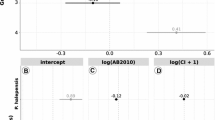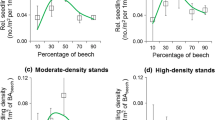Abstract
The balance between facilitation and competition is likely to change with age due to the dynamic nature of nutrient, water and carbon cycles, and light availability during stand development. These processes have received attention in harsh, arid, semiarid and alpine ecosystems but are rarely examined in more productive communities, in mixed-species forest ecosystems or in long-term experiments spanning more than a decade. The aim of this study was to examine how inter- and intraspecific interactions between Eucalyptus globulus Labill. mixed with Acacia mearnsii de Wildeman trees changed with age and productivity in a field experiment in temperate south-eastern Australia. Spatially explicit neighbourhood indices were calculated to quantify tree interactions and used to develop growth models to examine how the tree interactions changed with time and stand productivity. Interspecific influences were usually less negative than intraspecific influences, and their difference increased with time for E. globulus and decreased with time for A. mearnsii. As a result, the growth advantages of being in a mixture increased with time for E. globulus and decreased with time for A. mearnsii. The growth advantage of being in a mixture also decreased for E. globulus with increasing stand productivity, showing that spatial as well as temporal dynamics in resource availability influenced the magnitude and direction of plant interactions.



Similar content being viewed by others
References
Armas C, Pugnaire FI (2009) Ontogenetic shifts in interactions of two dominant shrub species in a semi-arid coastal sand dune system. J Veg Sci 20:535–546
Bauhus J, van Winden AP, Nicotra AB (2004) Above-ground interactions and productivity in mixed-species plantations of Acacia mearnsii and Eucalyptus globulus. Can J For Res 34:686–694
Bertness MD, Callaway RM (1994) Positive interactions in communities. Trends Ecol Evol 9:191–193
Binkley D (2003) Seven decades of stand development in mixed and pure stands of conifers and nitrogen-fixing red alder. Can J For Res 33:2274–2279
Boyden S, Binkley D, Senock R (2005) Competition and facilitation between Eucalyptus and nitrogen-fixing Falcataria in relation to soil fertility. Ecology 86:992–1001
Boyden S, Binkley D, Stape JL (2008) Competition among Eucalyptus trees depends on genetic variation and resource supply. Ecology 89:2850–2859
Brooker RW, Callaghan TV (1998) The balance between positive and negative plant interactions and its relationship to environmental gradients: a model. Oikos 81:196–207
Brundrett MC, Abbott LK (1991) Roots of Jarrah forest plants I. Mycorrhizal associations of shrubs and herbaceous plants. Aust J Bot 39:445–457
Callaway RM (1998) Competition and facilitation on elevation gradients in subalpine forests of the northern Rocky mountains, USA. Oikos 82:561–573
Callaway RM (2007) Positive interactions and interdependence in plant communities. Springer SBM, Dordrecht
Callaway RM, Walker LR (1997) Competition and facilitation: a synthetic approach to interactions in plant communities. Ecology 78:1958–1965
Forrester DI, Bauhus J, Khanna PK (2004) Growth dynamics in a mixed-species plantation of Eucalyptus globulus and Acacia mearnsii. For Ecol Manage 193:81–95
Forrester DI, Bauhus J, Cowie AL (2005) Nutrient cycling in a mixed-species plantation of Eucalyptus globulus and Acacia mearnsii. Can J For Res 35:2942–2950
Forrester DI, Bauhus J, Cowie AL (2006) Carbon allocation in a mixed-species plantation of Eucalyptus globulus and Acacia mearnsii. For Ecol Manage 233:275–284
Forrester DI, Schortemeyer M, Stock WD, Bauhus J, Khanna PK, Cowie AL (2007) Assessing nitrogen fixation in mixed- and single-species plantations of Eucalyptus globulus and Acacia mearnsii. Tree Physiol 27:1319–1328
Forrester DI, Theiveyanathan S, Collopy JJ, Marcar NE (2010) Enhanced water use efficiency in a mixed Eucalyptus globulus and Acacia mearnsii plantation. For Ecol Manage 259:1761–1770
Fox JC, Ades PK, Bi H (2001) Stochastic structure and individual-tree growth models. For Ecol Manage 154:261–276
Gardner JH, Malajczuk N (1988) Recolonisation of rehabilitated bauxite mine sites in western Australia by mycorrhizal fungi. For Ecol Manage 24:27–42
Gómez-Aparicio L, Gómez JM, Zamora R (2005) Microhabitats shift rank in suitability for seedling establishment depending on habitat type and climate. J Ecol 93:1194–1202
He X-H, Critchley C, Bledsoe C (2003) Nitrogen transfer within and between plants through common mycorrhizal networks (CMNs). Crit Rev Plant Sci 22:531–567
Isbell RF (1998) The Australian soil classification. CSIRO Publ, Collingwood
Khamzina A, Lamers JPA, Vlek PLG (2009) Nitrogen fixation by Elaeagnus angustifolia in the reclamation of degraded croplands of Central Asia. Tree Physiol 29:799–808
Khanna PK (1997) Comparison of growth and nutrition of young monocultures and mixed stands of Eucalyptus globulus and Acacia mearnsii. For Ecol Manage 94:105–113
Lloret F, Peñuelas J, Estiarte M (2005) Effects of vegetation canopy and climate on seedling establishment in Mediterranean shrubland. J Veg Sci 16:67–76
Miriti MN (2006) Ontogenetic shift from facilitation to competition in a desert shrub. J Ecol 94:973–979
Pretzsch H, Schütze G (2009) Transgressive overyielding in mixed compared with pure stands of Norway spruce and European beech in Central Europe: evidence on stand level and explanation on individual tree level. Eur J For Res 128:183–204
Reisman-Berman O (2007) Age-related change in canopy traits shifts conspecific facilitation to interference in a semi-arid shrubland. Ecography 30:459–470
Rousset O, Leopart J (2000) Positive and negative interactions at different lift stages of a colonizing species (Quercus humilis). J Ecol 88:401–412
Ryan MG, Binkley D, Fownes JH (1997) Age-related decline in forest productivity: pattern and process. Adv Ecol Res 27:213–262
Schiffers K, Teilbörger K (2006) Ontogenetic shifts in interactions among annual plants. J Ecol 94:336–341
Stace HCT, Hubble GD, Brewer R, Northcote KH, Sleeman JR, Mulcahy MJ, Hallsworth EG (1968) A handbook of Australian soils. Rellim, Glenside
Sthultz CM, Gehring CA, Whitham TG (2006) Shifts from competition to facilitation between a foundation tree and a pioneer shrub across spatial and temporal scales in a semiarid woodland. New Phytol 173:135–145
Tielborger K, Kadmon R (2000) Temporal environmental variation tips the balance between facilitation and interference in desert plants. Ecology 81:1544–1553
Vanclay JK (2006) Spatially-explicit competition indices and the analysis of mixed-species plantings with the Simile modelling environment. For Ecol Manage 233:295–302
Acknowledgments
David Forrester was funded by the Cooperative Research Centre for Forestry (Program 2) and an Alexander von Humboldt Research Fellowship. The experiment was established by the Commonwealth Scientific and Industrial Research Organisation, Division of Forestry, with the Department of Natural Resources and Environment, Victoria, providing the site and the Australian Centre for International Agricultural Research providing some financial support. We are also grateful to Partap Khanna, who established the experiment and provided early growth measurements. Three anonymous reviewers provided comments that improved the manuscript. Thank you also to John Collopy and Ben Smith who provided assistance in the field.
Author information
Authors and Affiliations
Corresponding author
Additional information
Communicated by Christian Wirth.
Rights and permissions
About this article
Cite this article
Forrester, D.I., Vanclay, J.K. & Forrester, R.I. The balance between facilitation and competition in mixtures of Eucalyptus and Acacia changes as stands develop. Oecologia 166, 265–272 (2011). https://doi.org/10.1007/s00442-011-1937-9
Received:
Accepted:
Published:
Issue Date:
DOI: https://doi.org/10.1007/s00442-011-1937-9




